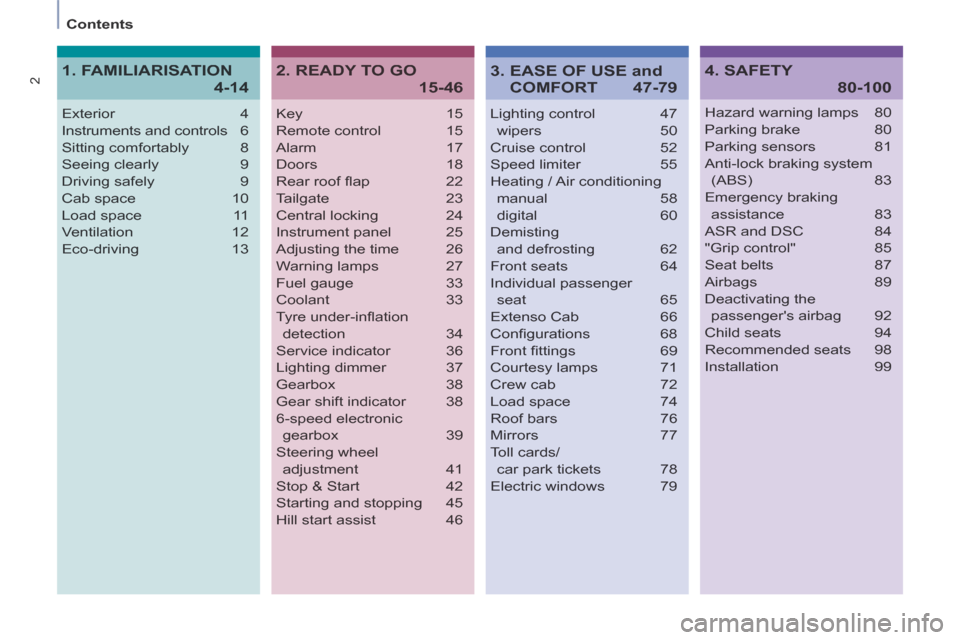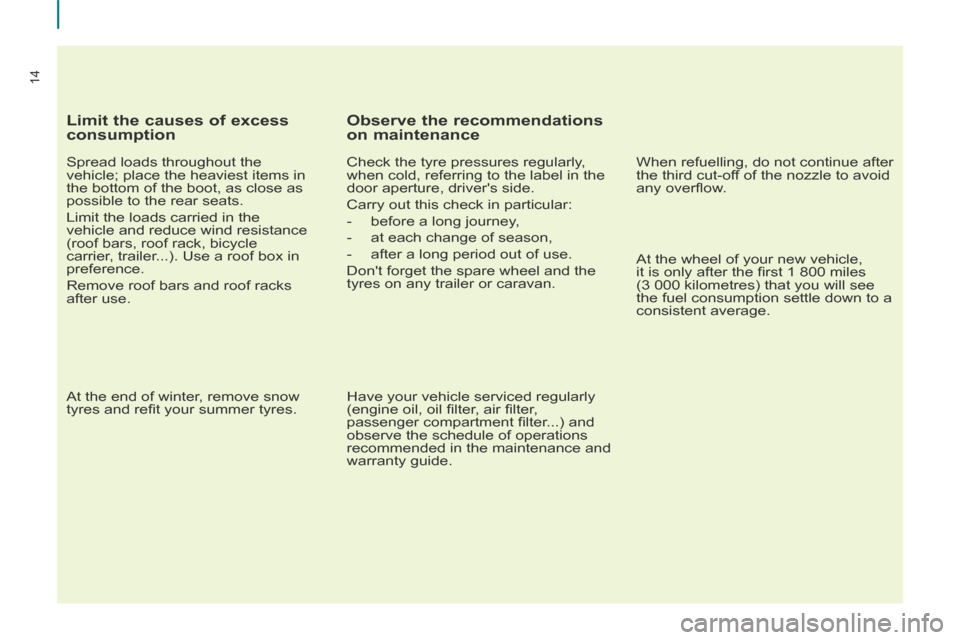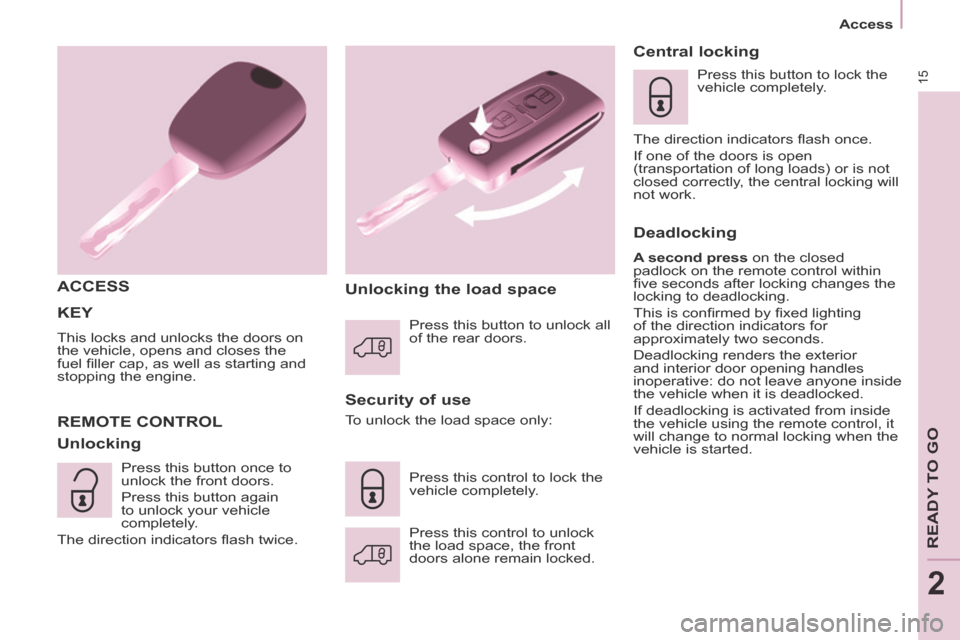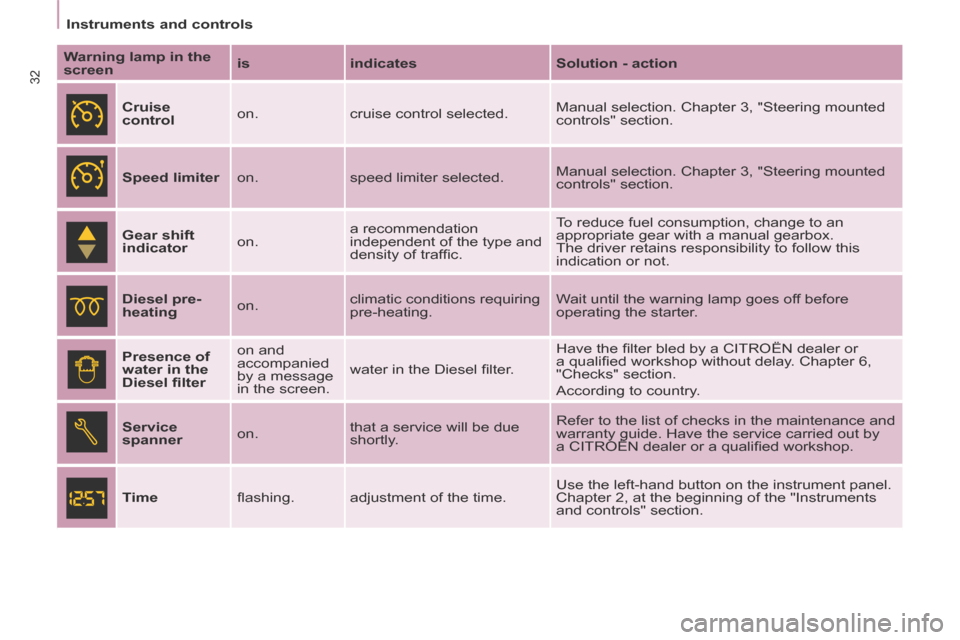fuel Citroen BERLINGO RHD 2014 2.G Owner's Manual
[x] Cancel search | Manufacturer: CITROEN, Model Year: 2014, Model line: BERLINGO RHD, Model: Citroen BERLINGO RHD 2014 2.GPages: 240, PDF Size: 12.09 MB
Page 4 of 240

2
Contents
Key 15
Remote control 15
Alarm 17
Doors 18
Rear roof fl ap 22
Tailgate 23
Central locking 24
Instrument panel 25
Adjusting the time 26
Warning lamps 27
Fuel gauge 33
Coolant 33
Tyre under-infl ation
detection 34
Service indicator 36
Lighting dimmer 37
Gearbox 38
Gear shift indicator 38
6-speed electronic
gearbox 39
Steering wheel
adjustment 41
Stop & Start 42
Starting and stopping 45
Hill start assist 46
Lighting control 47
wipers 50
Cruise control 52
Speed limiter 55
Heating / Air conditioning
manual 58
digital 60
Demisting
and defrosting 62
Front seats 64
Individual passenger
seat 65
Extenso Cab 66
Confi gurations 68
Front fi ttings 69
Courtesy lamps 71
Crew cab 72
Load space 74
Roof bars 76
Mirrors 77
Toll cards/
car park tickets 78
Electric windows 79
Exterior 4
Instruments and controls 6
Sitting comfortably 8
Seeing clearly 9
Driving safely 9
Cab space 10
Load space 11
Ventilation 12
Eco-driving 13
Hazard warning lamps 80
Parking brake 80
Parking sensors 81
Anti-lock braking system
(ABS) 83
Emergency braking
assistance 83
ASR and DSC 84
"Grip control" 85
Seat belts 87
Airbags 89
Deactivating the
passenger's airbag 92
Child seats 94
Recommended seats 98
Installation 99
2. READY TO GO
15-46
4. SAFETY
80-100
1. FAMILIARISATION
4-14
3. EASE OF USE and
COMFORT 47-79
Page 5 of 240

3
Contents
CONTENTS
Emergency
or assistance 9.1
eMyWay 9.3
Audio system 9.63
Towing a trailer 101
Other accessories 102
Trade range 102
Telematic unit 103
Opening the bonnet 105
Petrol engine 106
Diesel engine 107
Levels 108
Checks 110
Fuel 112
Fuel cut-off 113
Diesel priming pump 113
Battery 114
Changing a wheel 116
Removable snow
screen 120
Snow chains 121
Changing
a bulb 122
a fuse 127
a wiper blade 131
Being towed 132
Dimensions 133
Weights 138
Identifi cation markings 139
Exterior 141
Instruments
and controls 142
Interior 146
Technical data -
Maintenance 148
9. TECHNOLOGY on
BOARD
5. ACCESSORIES
101-103
7. QUICK HELP
114-132
10. VISUAL SEARCH
141-148
6. CHECKS
104-113
8. TECHNICAL
D ATA133-140
The "Visual search" section
assists you in fi nding the
controls and functions
and their associated page
numbers on the schematic
outlines of the vehicle (visual
index).
The "Technology on board"
section presents the new
audio/navigation systems.
corresponds to a left
hand drive vehicle. corresponds to
a right hand drive
vehicle.
Page 15 of 240

13
1
FAMILIARISATION
ECO-DRIVING
Eco-driving is a range of everyday practices that allow the motorist to \
optimise their fuel consumption and CO2
emissions.
Optimise the use of your
gearbox
With a manual gearbox, move
off gently and change up without
waiting. During acceleration change
up early.
With an automatic or electronic
gearbox, give preference to
automatic mode and avoid pressing
the accelerator pedal heavily or
suddenly.
The gear shift indicator invites you
engage the most suitable gear: as
soon as the indication is displayed in
the instrument panel, follow it straight
away.
For vehicles fi tted with an electronic
or automatic gearbox, this indicator
appears only in manual mode.
Control the use of your
electrical equipment
Before moving off, if the passenger
compartment is too warm, ventilate it
by opening the windows and air vents
before using the air conditioning.
Above 30 mph (50 km/h), close the
windows and leave the air vents open.
Remember to make use of equipment
that can help keep the temperature
in the passenger compartment down
(sunroof and window blinds...). Switch off the headlamps and front
foglamps when the level of light does
not require their use.
Avoid running the engine before
moving off, particularly in winter; your
vehicle will warm up much faster
while driving.
Drive smoothly
Maintain a safe distance between
vehicles, use engine braking rather
than the brake pedal, and press the
accelerator progressively. These
practices contribute towards a
reduction in fuel consumption and CO
2
emissions and also helps reduce the
background traffi c noise.
If your vehicle has cruise control,
make use of the system at speeds
above 25 mph (40 km/h) when the
traffi c is fl owing well.
As a passenger, if you avoid
connecting your multimedia devices
(fi lm, music, video game...), you
will contribute towards limiting the
consumption of electrical energy, and
so of fuel.
Disconnect your portable devices
before leaving the vehicle. Switch off the air conditioning, unless
it has automatic regulation, as
soon as the desired temperature is
attained.
Switch off the demisting and
defrosting controls, if not automatic.
Switch off the heated seat as soon as
possible.
Page 16 of 240

14
Limit the causes of excess
consumption
Spread loads throughout the
vehicle; place the heaviest items in
the bottom of the boot, as close as
possible to the rear seats.
Limit the loads carried in the
vehicle and reduce wind resistance
(roof bars, roof rack, bicycle
carrier, trailer...). Use a roof box in
preference.
Remove roof bars and roof racks
after use.
At the end of winter, remove snow
tyres and refi t your summer tyres.
Observe the recommendations
on maintenance
Check the tyre pressures regularly,
when cold, referring to the label in the
door aperture, driver's side.
Carry out this check in particular:
- before a long journey,
- at each change of season,
- after a long period out of use.
Don't forget the spare wheel and the
tyres on any trailer or caravan.
Have your vehicle serviced regularly
(engine oil, oil fi lter, air fi lter,
passenger compartment fi lter...) and
observe the schedule of operations
recommended in the maintenance and
warranty guide. When refuelling, do not continue after
the third cut-off of the nozzle to avoid
any overfl ow.
At the wheel of your new vehicle,
it is only after the fi rst 1 800 miles
(3 000 kilometres) that you will see
the fuel consumption settle down to a
consistent average.
Page 17 of 240

15
Access
READY TO GO
2
KEY
This locks and unlocks the doors on
the vehicle, opens and closes the
fuel fi ller cap, as well as starting and
stopping the engine.
ACCESS Security of use
REMOTE CONTROL
Unlocking Unlocking the load space Central locking
Press this button to lock the
vehicle completely.
The direction indicators fl ash once.
If one of the doors is open
(transportation of long loads) or is not
closed correctly, the central locking will
not work.
Deadlocking
A second press on the closed
padlock on the remote control within
fi ve seconds after locking changes the
locking to deadlocking.
This is confi rmed by fi xed lighting
of the direction indicators for
approximately two seconds.
Deadlocking renders the exterior
and interior door opening handles
inoperative: do not leave anyone inside
the vehicle when it is deadlocked.
If deadlocking is activated from inside
the vehicle using the remote control, it
will change to normal locking when the
vehicle is started.
To unlock the load space only:
Press this control to unlock
the load space, the front
doors alone remain locked. Press this control to lock the
vehicle completely. Press this button to unlock all
of the rear doors.
Press this button once to
unlock the front doors.
Press this button again
to unlock your vehicle
completely.
The direction indicators fl ash twice.
Page 27 of 240

2
Instruments and controls
25
READY TO GO
INSTRUMENTS AND CONTROLS
INSTRUMENT PANEL
Dials
1. Distance recorder in kilometres / miles.
2. Screen.
3. Fuel level, coolant temperature.
4. Rev counter.
5. Trip distance recorder / service indicator zero reset.
6. Instrument panel lighting dimmer. Displays
- Speed limiter / cruise control.
- Kilometres / Miles travelled.
- Service indicator, engine oil level
indicator, total kilometres / miles.
- Presence of water in the Diesel fi lter.
- Diesel pre-heating. Screens
The format of the information
presented in the screen depends on
the vehicle's equipment.
Page 31 of 240

2
Instruments and controls
29
READY TO GO
Warning lamp is indicates Solution - action
Front / lateral
airbag fl ashing or
remaining on.
a failure of an airbag. Have the system checked by a CITROËN dealer
or a qualifi ed workshop without delay. Chapter 4,
"Airbags" section.
Front
passenger's
airbag
deactivated on. the intentional deactivation
of this airbag in the
presence of a rearward
facing child seat. Chapter 4, "Airbags-child safety" section.
Low fuel
level on with gauge
needle in the
red zone. When it fi rst comes on,
there remains around
8 litres of fuel in the tank.
The distance you can drive
on this fuel depends on
your style of driving and the
engine type. You must fi ll up with fuel to avoid running out.
This warning lamp comes on each time you
switch on the ignition until you have fi lled up.
Capacity of the tank: approximately 60 litres.
Never risk driving until the tank is empty, this
could damage the emissions and injection
systems.
fl ashing. cutting off of the fuel supply
following a serious impact. Restore the supply. Chapter 6, "Fuel" section.
EOBD
emission
control
system fl ashing or
remaining on.
a failure of the system. There is a risk of damage to the catalytic
converter. Have it checked by a CITROËN
dealer or a qualifi ed workshop.
Battery
charge on.
a fault in the charging
circuit. Check the battery terminals, … Chapter 7,
"Battery" section.
fl ashing. placing of the active
functions on standby
(economy mode). Chapter 7, "Battery" section.
remaining on,
in spite of the
checks. a faulty circuit, an ignition or
injection malfunction.
Have it checked by a CITROËN dealer or
a qualifi ed workshop.
Page 34 of 240

Instruments and controls
32
Warning lamp in the
screen is
indicates Solution - action
Cruise
control on.
cruise control selected. Manual selection. Chapter 3, "Steering mounted
controls" section.
Speed limiter on. speed limiter selected. Manual selection. Chapter 3, "Steering mounted
controls" section.
Gear shift
indicator on. a recommendation
independent of the type and
density of traffi c. To reduce fuel consumption, change to an
appropriate gear with a manual gearbox.
The driver retains responsibility to follow this
indication or not.
Diesel pre-
heating on. climatic conditions requiring
pre-heating. Wait until the warning lamp goes off before
operating the starter.
Presence of
water in the
Diesel fi lter on and
accompanied
by a message
in the screen.
water in the Diesel fi lter. Have the fi lter bled by a CITROËN dealer or
a qualifi ed workshop without delay. Chapter 6,
"Checks" section.
According to country.
Service
spanner on. that a service will be due
shortly. Refer to the list of checks in the maintenance and
warranty guide. Have the service carried out by
a CITROËN dealer or a qualifi ed workshop.
Time fl ashing. adjustment of the time. Use the left-hand button on the instrument panel.
Chapter 2, at the beginning of the "Instruments
and controls" section.
Page 35 of 240

2
Instruments and controls
33
READY TO GO
FUEL GAUGE COOLANT TEMPERATURE
The needle is positioned before the
red zone: normal operation.
In arduous conditions of use or hot
climatic conditions, the needle may
move close to the red graduations. What you should do if the needle
enters the red zone:
Reduce your speed or let the engine
run at idle.
What you should do if the warning
lamp comes on:
- stop immediately, switch off the
ignition. The fan may continue to
operate for a certain time, up to
approximately 10 minutes,
- wait for the engine to cool down in order to check the coolant level and
top it up if necessary.
As the cooling system is pressurised,
follow this advice in order to avoid any
risk of scalding:
- wait at least one hour after switching off the engine before
carrying out any work,
- unscrew the cap by 1/4 turn to allow the pressure to drop,
- when the pressure has dropped, check the level on the expansion
bottle,
-
if necessary, remove the cap to top up.
If the needle remains in the red
zone, have the system checked by
a CITROËN dealer or a qualifi ed
workshop.
Refer to the "Levels" section of
chapter 6.
Refer to the "Fuel" section of
chapter 6.
The fuel level is tested each time the
key is turned to the "running" position.
The gauge is positioned on:
- 1: the fuel tank is full,
approximately 60 litres.
- 0: the reserve is now being used, the warning lamp comes on
continuously. The reserve when
the warning fi rst comes on is
approximately 8 litres.
Page 36 of 240

Instruments and controls
34
TYRE UNDER-INFLATION DETECTION EMISSIONS CONTROLS
System which
automatically checks the
pressures of the tyres
while driving.
EOBD (European On
Board Diagnosis) is a
diagnostics system which
complies with, among
others, the standards
concerning authorised emissions of:
- CO (carbon monoxide),
- HC (unburnt hydrocarbons),
- NOx (nitrous oxides) or particles, detected by oxygen sensors placed
upstream and downstream of the
catalytic converters.
The driver is warned of any malfunction
of this emission control system by the
illumination of this specifi c warning
lamp in the instrument panel.
There is a risk of damage to the
catalytic converter. Have it checked
by a CITROËN dealer or a qualifi ed
workshop. The system continuously monitors the
pressures of the four tyres, as soon as
the vehicle is moving.
A pressure sensor is located in the
valve of each tyre (except the spare
wheel).
The system triggers an alert if a drop
in pressure is detected in one or more
tyres.
The tyre under-infl ation detection
system is an aid to driving which
does not replace the need for
the driver to be vigilant or to drive
responsibly. This system does not avoid the
need to check the tyre pressures
regularly (including the spare
wheel) and before a long journey.
Driving with under-infl ated tyres
adversely affects road holding,
extends braking distances and causes
premature tyre wear, particularly under
arduous conditions (vehicle loaded,
high speed, long journey).
Driving with under-infl ated tyres
increases fuel consumption.
The tyre pressures for your vehicle
can be found on the tyre pressure
label (see the "Identifi cation
markings" section).
The tyre pressures must be checked
when the tyres cold (vehicle stopped
for 1 hour or after driving for less then
6 miles (10 km) at moderate speed).
Otherwise, add 0.3 bar to the values
indicated on the label.